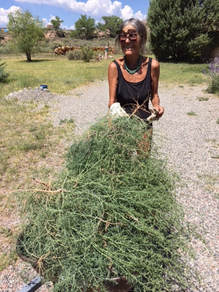 Every time my little dogs and I walked into Owl canyon last winter and spring, one or both dogs would step on a tumbleweed spine. Some days I was extracting these little monsters from my dogs’ feet a dozen times or more, while they held up a tormented paw with a pitiful look. No matter how carefully I scanned the arroyo for tumbleweed I just couldn’t avoid them. After moving into this adobe house, I began the process of land reclamation casting wildflower seeds that I had collected last year, and began watering the disturbed and barren earth – a normal consequence of building a new house. I also removed every tumbleweed skeleton in sight from the bare ground – a massive undertaking – with the hope that I could stem the tumbleweed tide. To my horror the first seeds that sprouted were tumbleweeds! That was almost three months ago, and today I daily fry uprooted tumbleweeds on hot stones while ruefully accepting the inevitable – I will be weeding tumbleweeds indefinitely! In this process I have developed a begrudging respect for this plant that is a true survivor! It loves wastelands and I am amazed by the plants’ tenacity and determination to reproduce. When the plant is young it is quite pretty with its purple stems and lacy stems shaped like a rosette, but I learned the hard way that if I broke the plant from its root, two days later I would be pulling two or three thick rooted tumbleweeds where originally there had been one! I am not naïve enough to believe that I will ever be able to eradicate this plant, but my intention is to persevere because around the house I want my dogs to be able to run around without prickers in their feet. "Tumbleweed," "Russian thistle" and "wind witch" are common names for this plant. (“Wind witch” annoys me. I am tired of women being attached to plants that are considered dangerous or are considered pests. The war on women – especially old women - never ends.) Russian thistle alludes to its Eurasian origin. Scientific names for tumbleweed begin with the Latin word Salsola in reference to the plant’s salt tolerance. Virtually everyone recognizes a mature Russian thistle, which looks like the skeleton of a normal shrub. Plants may be as small as a soccer ball or as large as a Volkswagen beetle! One flew over the Trailercita last spring that boggled my mind – a gigantic beach ball! The seedling and juvenile plant’s bright green, succulent, grass-like shoots have tiny green flowers each one accompanied by a pair of spiny bracts. Mice, bighorn sheep, and pronghorn eat the tender shoots. I personally have never seen tumbleweed nibbled on by anything. As they roll down a desert road, tumbleweeds disperse seeds. Seeds are unusual in that they lack any protective coat or stored food reserves. Instead, each seed is a coiled, embryonic plant wrapped in a thin membrane. To survive winter without a warm coat, the plant does not germinate until warm weather arrives. When moisture falls, it quickly sends up two needle-like leaves and begins to shoot skyward. By autumn the plant has reached maximum size, flowered and begun to dry out. A specialized layer of cells in the stem facilitates the easy break between plant and root, and the journey begins anew. Like many weeds, Russian thistle exploited the destruction of native ecosystems and continues to do so today. When farmers removed prairie grasses, they created a perfect environment, smooth and flat, for a plant that could roll across the landscape dispersing seeds. Unfortunately herbicides are used to control the spread of tumbleweeds by disrupting the maturation process of the plant. Recently the U.S. Agricultural Research Service announced the discovery of two promising fungal pathogens that infect and kill tumbleweeds. Not surprisingly, the fungi were uncovered in infected Russian thistle plants growing on the Eurasian steppes — the original home of tumbleweeds. Tumbleweeds were first reported in the United States in the 1800’s apparently transported in flax seed imported by Ukrainian farmers. Within two decades the plant had tumbled into a dozen states, and by 1900, tumbleweed had reached the Pacific Coast. Tumbleweeds have never stopped spreading. Nearly every state in the U.S. is now home to Russian thistle, as well as several newer GIANT tumbleweed species that arrived as immigrants from around the world. Tumbleweeds grow everywhere from Canada to South Africa! Each winter after the plants die, the brittle bushy parts snap off at the roots and blow away, dispersing seeds wherever they tumble - about 250,000 per plant – a mindboggling statistic for anyone, like me, who wants to keep these intrepid survivors under control!
1 Comment
Terry Rich
8/17/2018 01:21:49 pm
So interesting and good writing, too. Thanks for the information.
Reply
Your comment will be posted after it is approved.
Leave a Reply. |
Submit your ideas for local feature articles
Profiles Gardening Recipes Observations Birding Essays Hiking AuthorsYou! Archives
October 2025
Categories
All
|
 RSS Feed
RSS Feed